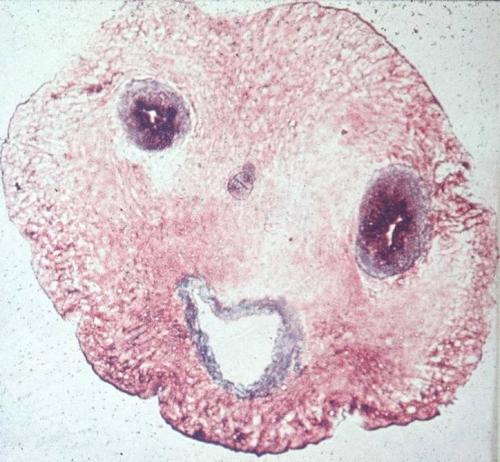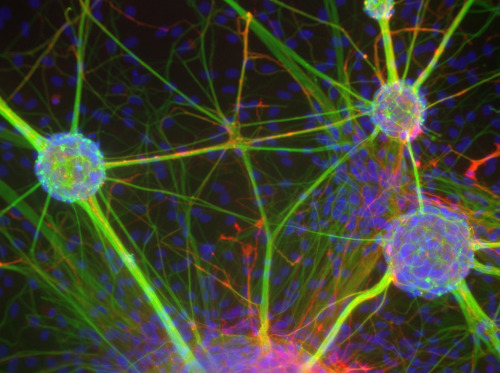Феерические новости - клетки кожи генерируют сигналы и очень странно себя ведут. Подробный анализ этого интереснейшего предположения предлагаю рассмотреть, спасибо Dr. Jeffrey H. Toney, который написал статью у себя в блоге http://scienceblogs.com/deanscorner/2011/05/could_skin_cells_think.php:
Figure 4: Synaptic responses of HFF-iN cells.
There seems to be a brain-centric theme emerging this week in groundbreaking science. Scientists at the Stanford University School of Medicine have reported in Nature the first example of transforming human skin cells into functional nerve cells. Could skin cells someday be able to "think"? Could they be used to create a biological computer or in regenerative medicine?
How did they do it? Excerpted, and revised for clarity, from their Abstract: {my comments in italics}
Somatic cell nuclear transfer, cell fusion, or expression of lineage-specific factors have been shown to induce cell-fate changes in a variety of cell types. We recently observed that forced expression of a combination of three transcription factors {factors that affect how genes become expressed} can efficiently convert mouse fibroblasts into functional induced neuronal (iN) cells13. Here we show that the same three factors can generate functional neurons from human pluripotent stem cells as early as 6 days after transgene activation. Importantly, the vast majority of human iN cells were able to generate action potentials and many matured to receive synaptic contacts when co-cultured with primary mouse cortical neurons. Our data demonstrate that non-neural human somatic cells, as well as pluripotent stem cells, can be converted directly into neurons by lineage-determining transcription factors. These methods may facilitate robust generation of patient-specific human neurons for in vitro disease modelling or future applications in regenerative medicine.
Their conclusions:
In this report, we have identified a combination of transcription factors that are capable of converting human fibroblasts directly into neurons. Like mouse iN cells13 and neurons derived from ES cells19, 20, 21 and iPS cells22, 23, the human iN cells seem relatively immature, as indicated by their slightly depolarized membrane potentials and the relatively low-amplitude synaptic responses. Compared to mouse iN cells, human iN cells required longer culture periods to develop synaptic activity. Future studies will be necessary to thoroughly optimize conditions for human iN cell generation and maturation, which would facilitate applications of this method for the study of human neuronal development and disease.
This is, yet another, amazing example of a creative use of biological techniques to generate something thought to be impossible in the past - transforming a common skin cell into a functioning neuron!
Figure 4: Synaptic responses of HFF-iN cells.
There seems to be a brain-centric theme emerging this week in groundbreaking science. Scientists at the Stanford University School of Medicine have reported in Nature the first example of transforming human skin cells into functional nerve cells. Could skin cells someday be able to "think"? Could they be used to create a biological computer or in regenerative medicine?
How did they do it? Excerpted, and revised for clarity, from their Abstract: {my comments in italics}
Somatic cell nuclear transfer, cell fusion, or expression of lineage-specific factors have been shown to induce cell-fate changes in a variety of cell types. We recently observed that forced expression of a combination of three transcription factors {factors that affect how genes become expressed} can efficiently convert mouse fibroblasts into functional induced neuronal (iN) cells13. Here we show that the same three factors can generate functional neurons from human pluripotent stem cells as early as 6 days after transgene activation. Importantly, the vast majority of human iN cells were able to generate action potentials and many matured to receive synaptic contacts when co-cultured with primary mouse cortical neurons. Our data demonstrate that non-neural human somatic cells, as well as pluripotent stem cells, can be converted directly into neurons by lineage-determining transcription factors. These methods may facilitate robust generation of patient-specific human neurons for in vitro disease modelling or future applications in regenerative medicine.
Their conclusions:
In this report, we have identified a combination of transcription factors that are capable of converting human fibroblasts directly into neurons. Like mouse iN cells13 and neurons derived from ES cells19, 20, 21 and iPS cells22, 23, the human iN cells seem relatively immature, as indicated by their slightly depolarized membrane potentials and the relatively low-amplitude synaptic responses. Compared to mouse iN cells, human iN cells required longer culture periods to develop synaptic activity. Future studies will be necessary to thoroughly optimize conditions for human iN cell generation and maturation, which would facilitate applications of this method for the study of human neuronal development and disease.
This is, yet another, amazing example of a creative use of biological techniques to generate something thought to be impossible in the past - transforming a common skin cell into a functioning neuron!











0 +:
Dí lo que piensas...